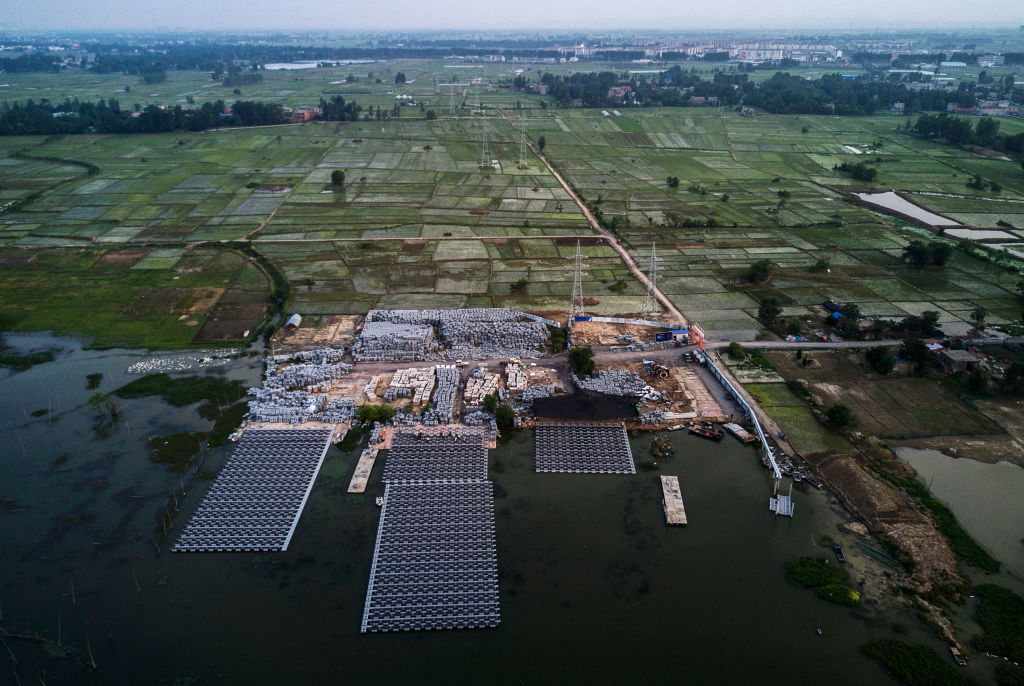China is on a mission to become the next green superpower. The country is the largest investor in renewable energy, sinking $126.6 billion into the industry in 2017, a 30% increase from the year prior.
Solar is a big part of those investments. By 2020, China hopes to be generating 110 gigawatts of solar power – enough to power more than 30 million homes – as part of an ambitious plan to cut carbon emissions. By 2030, China vows to increase the amount of energy coming from non-fossil fuels to 20% of the total (from about 13% currently).
China’s shift away from coal and other fossil fuels has accelerated in the last decade. In the past several years, the country has developed several massive solar farms, and the trend doesn’t seem to be slowing down any time soon.
Take a look below.
Chinese cities have some of the worst smog in the world, resulting in thousands of air pollution-related deaths every year.

According to a 2016 study, the top contributor of air pollution-related deaths in China is the burning of coal. The team of Chinese and American researchers behind the study said that pollution from coal caused 366,000 premature deaths in 2013.
To alleviate pollution, the country is gradually shifting to solar and other renewable energy sources.

In 2013, China started building the Jinchang Solar Power Station in Gansu Province. Three satellites from European Space Agency and the US Geological Survey captured images of its construction. The imaging startup Descartes Labs then turned them into this time-lapse from April 2013 to April 2018:
The satellites were all in low-Earth orbit approximately 470 miles above the ground.
The 85-megawatt project totaled nearly $300 million, and can provide power to about 50,000 homes.

Source: Clean Technica
Another solar power plant in Datong, China, had a little fun with its design.

Source: Business Insider
In 2017, China Merchants New Energy Group, one of the country's largest clean energy operators, built a solar farm in the shape of two giant pandas. It can supply power to 10,000 homes.

Source: Business Insider
The Longyangxia Dam Solar Park is more massive. With 850 megawatts of capacity, it's the largest solar farm in the world. The time-lapse below, created by Descartes Labs, shows its construction from April 2013 to April 2018.
There are nearly 4 million solar panels at the site, which can accommodate up to 200,000 households.

Source: The Guardian
Longyangxia Dam will likely not remain the world's largest solar park for long. A project planned for the Ningxia region in China’s northwest will have a capacity of 2,000 megawatts when complete, enough to power up to 450,000 homes.

It's expected to come online within the next few years.
Source: Bloomberg
This year marks China's fourth anniversary since it started a "war on pollution."

And there's reason to believe the country is making headway.

Looking at over 200 monitors throughout China, a recent analysis found that Chinese cities have cut concentrations of fine particulates - often considered the deadliest type of pollution - by 32% on average since 2013. The city of Xingtai saw the largest pollution decline at 52.2%.
If China sustains these reductions, the average resident could see their lifespan extend by 2.4 years, according to the researchers.
In late 2017, China completed construction of a floating solar farm, built on top of an abandoned coal mine in the Anhui Province.

Earlier this year, workers turned on the 166,000-panel array, which can generate 40 megawatts of power — enough to accommodate 15,000 homes.

It's currently the world's largest floating solar project and will operate for up to 25 years.

Floating solar farms use flotation devices, seen below, which help it stay above water.

In December, a unit of China's Three Gorges Corp. started building an even larger floating solar farm.

Also in Anhui, this $151 million plant will produce up to 150 megawatts of power for approximately 94,000 homes. It's expected to come online some time this year.

Ryan Keisler, Descartes Labs' head of applied science, told Business Insider that these solar-energy megaprojects could create a dim future for fossil fuels.

"The rest of the world combined has more solar capacity than China, but not by much," he said. "And it seems that it's only a matter of time before China surpasses everyone else combined."


